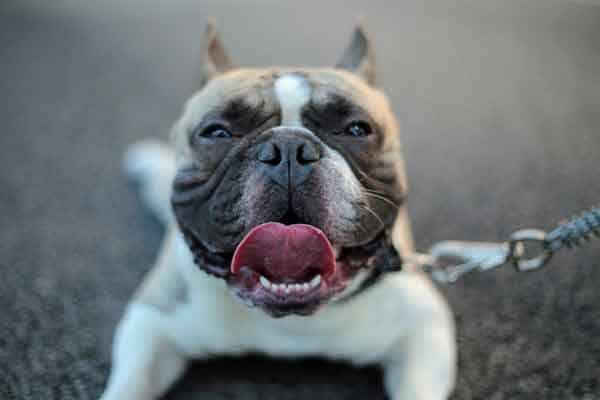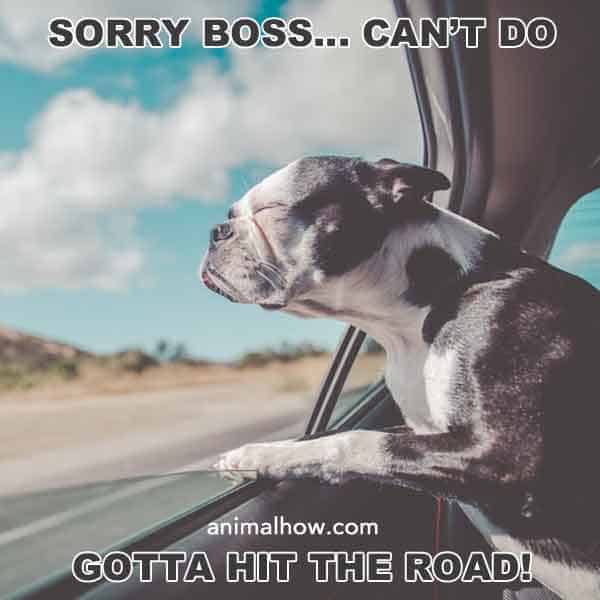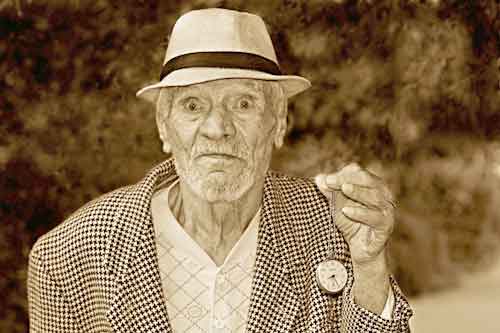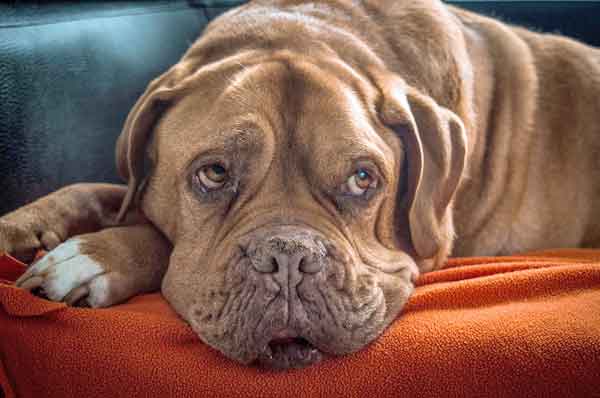Sometimes it feels like dogs are shedding all year round. This is sometimes the case (as we will look at) but when are the main shedding seasons?
When Do Dogs Shed The Most?
Dogs typically change their coat when winter turns to spring and again when summer turns to fall. They shed the summer coat for a warmer winter coat and vice versa. Many domesticated dogs shed all year round if they are kept indoors most of the time.
Let’s dig into the details!
Table of Contents
The Main Shedding Seasons For Dogs
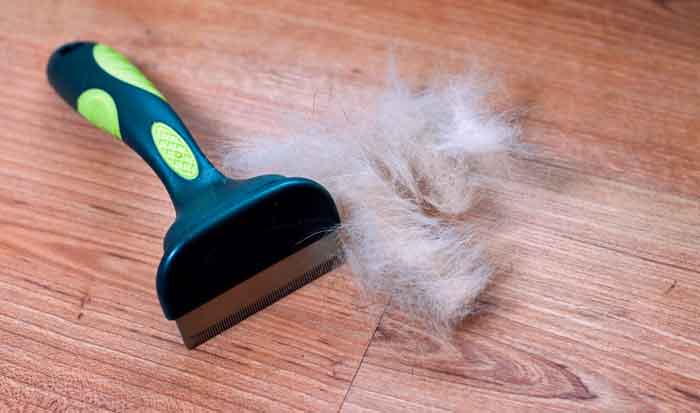
As we mentioned above, most dogs will change their coat when the main seasons change. This is when winter turns to spring and again when summer turns to fall.
| Season | Amount Of Shedding |
| Spring | Much shedding as the dog changes from a winter coat to a summer coat |
| Summer | Least shedding |
| Fall | Much shedding as the dog changes from a summer coat to a winter coat |
| Winter | Moderate shedding as the coat is thicker |
As you can see in the table above, you should expect the most shedding from your dog around springtime.
This is simply because the fur from the winter coat is thick and furry and now it’s time to let go of some of it in order to get a thinner summer coat.
The reason they do this is that they generate a thicker coat for the cold winter months and during the summer they don’t need as much insulation and fur.
The hair from the winter coat will start to fall off when the sun starts to shine more and the days get longer. The dog might also react to warmer weather. These are the signs that tell the dog that it’s time for a new coat and the shedding will start.
How Long Does The Shedding Season Last?
It typically takes around 2 to 4 weeks for the double-coated dog to “blow” the undercoat, as it is called when they start shedding the winter coat for the summer coat.
During this time you need to brush your dog every day.
That’s the best (and the only) way to make sure all the dog hair doesn’t end up on your sofas and everywhere else inside your house.
Some dogs will take a longer time and other dog breeds would do it more quickly. This largely depends on how thick the coat is and how fast the dog reacts to the changing weather. It also depends on whether the dog has a double-layered coat or a single-layered coat.
It’s a good idea to keep your dog out as much as the time doing this period of the year.
This might seem obvious as you will have a lot of shedding going on. That there are other reasons why you also should do this. You can speed up the process and help the dog to adapt to the new season by letting it out more frequently and expose it to sunshine and the warm weather.
By doing so, you will help this dog to understand that now it’s time for warmer weather and it’s time to shed some of that extensive fur that has been building up during the winter months.
When Do Dogs Shed The Least?
Dogs normally shed the least during the summer period.
This is because they have already shifted the winter coat in the spring so the new coat has grown out with a thinner layer for the warm weather.
So, now we have a dog with a thin coat and it’s not time just yet to let go of it in order to make room for the thicker winter coat.
This is why we see the least amount of shedding among dogs during the summer.
But you will never completely get rid of the shedding. Dogs will always shed more or less and especially when we are talking about dogs with thick coats or even double-layered coats.
There’s simply just no way to let go of the shedding and you will still need to brush the dog. But during the warm summer months, you can often get away with brushing the dog only a couple of times per week. This is a lot less than during the spring season where you should definitely brush the dog daily.
(How Much) Do Dogs Shed Before Winter?
Dogs will shed the most in the spring but they also shed the summer coat in the weeks leading up to the winter months. Dogs with thick coats can shed several handfuls of fur each day in the last weeks of the fall to make room for the thicker winter coat.
Now you know that the winter coat has to go as soon as winter turns to spring.
But what about the amount of shedding in the fall, how much shedding should be expected leading up to the winter season?
Because the summer coat is thinner and less puffy than the winter coat, the shedding just before winter is not as extensive as the shedding in the spring. You should expect to brush the dog often but the hair and the fur is thinner and more lightweight.
That being said, you will need to have a daily brushing routine during the late fall as the fall turns to winter. The dog is making room for the thicker coat and this is especially true for the double-coated dogs.
The double-coated dogs will start shedding quite extensively in the fall as well as in the spring. But remember, that domesticated dogs that live inside city apartments typically shed all year round. This is hard to avoid if they did not have regular access to open fields and sunshine.
5 tips To Reduce Shedding During The Main Shedding Seasons
There are many tricks and things you can do in order to reduce the shedding as much as possible.
These tips can be real lifesavers for dog owners during the main shedding seasons as the hair will be all over the place! Here are our best tips for reducing the amount of shedding in spring and fall.
1) Brush the dog with a rubber glove
First and foremost you need to brush the dog daily as we mentioned above. But that’s obvious for most dog owners so here are a couple of other things you can do as well.
These rubber gloves are great:

You can find a link to these gloves here.
Even though they look like they were taken right out of the steampunk movies they work really well on most dog breeds.
The rubber spikes will go into the fur and straighten out the hairs. It’s a great tool for the initial brush before you go into the deeper undercoat if you have a double-coated dog. They also work great on dogs with a single layer of hair because they are comfortable for the dog and the combing will feel like you are stroking it.
2) Spray (and feed the dog) with coconut oil
Coconut oil has shown over and over again to reduce shedding among dogs.
There something inside the coconut oil that creates a more healthy coat and stronger hair. You can simply take a tablespoon of coconut oil and mix it up with water in order to spray it directly on the dog.
You can also feed the dog a little spoon of coconut oil.
You just need to make sure to introduce it a little bit of the time because if the dog isn’t used to eating coconut oil it might react to it the first couple of times.
We don’t want a dog with diarrhea just because we were trying to reduce the shedding. That would just create a whole new level of problems 🙂
3) Special de-shedding shampoo
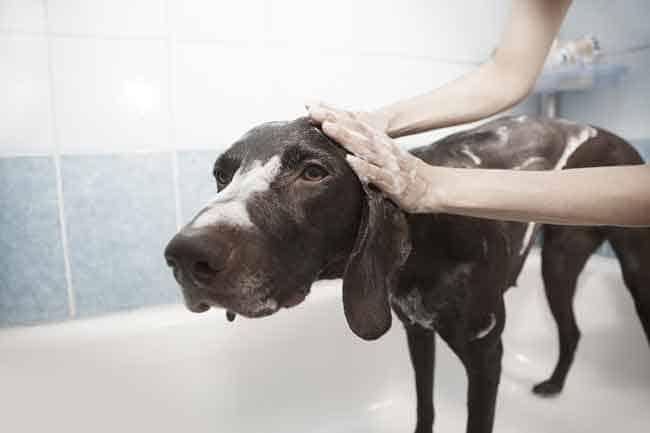
It’s a good idea to wash your dog more frequently during the peak seasons of shedding.
Every time you wash your dog you need to make sure you have combed the hair before you get it wet. As soon as the coat gets wet it gets harder to untangle the little knots inside the fur. This is especially true for long-haired dogs. Give it a good brush before you turn on the water.
As soon as you have the dog wet all over you can start adding a bit of a special de-shedding shampoo.
You can find a very effective shampoo on this shop. You should also check our list of must-haves for dog owners.
The special shampoo is very rich on the fatty acids that the dog needs in order to keep a healthy coat.
Remember to always use a shampoo that is completely free of parabens and artificial colors. We don’t want the dog to develop allergies just because we are trying to reduce the shedding. The shampoo we link to above is 100% free of chemical dyes as well as parabens.
4) Diets with fatty acids and nutrients
You can also feed the dog the fatty acids through the dog food.
These are essential for the dog in order to keep a healthy coat and they will also strengthen the hairs in order for them to stay on the coat longer.
There are a lot of different types of dog food out there and you should make sure to get good quality food. This is not the place to save a few bucks because if you’re your feed your dog bad food it will (probably) start shedding more and be more likely to develop health issues.
It’s important to not only feed your dog the waste and left-overs from your dinner and what else you have in the fridge. Dogs need a good solid meal in order to get all the nutrients and vitamins they need for healthy skin and a good life.
Just like you and me.
5) Vacuum cleaners made for pet hair
It’s important to use a special type of vacuum cleaner when you are trying to get rid of pet hair.
A normal vacuum cleaner will simply not get the job done because the brush-roller will quickly fill up with tangles dog hair and simply stop working.
We have found the best vacuum cleaners for dog hairs for you and you can see here why they work so much better.
They have an extra set of rollers in front of the main brush-roller that takes care of the dog’s hair. It will suck up the dog hair without getting it stuck in the rotating parts which will totally cloak the system.

You can find more information here on these special vacuum cleaners.
They are actually quite affordable – and they also come in a handheld wall-mounted model which is great for vacuuming the car and the furniture 😉
Why Do My Dog Shed All Year Round?
Even though the main shedding seasons are linked to the change of the main seasons and temperatures outside, there are other factors that come into play for domesticated dogs.
Remember, the dogs used to live in nature as wild dogs. Among wild dogs, the fur and hair will automatically change along with the changing weather of the seasons. But this is not always the case with domesticated dogs that live most of their life indoors.
Extensive shedding can also be triggered by other factors such as indoor heating and the use of air conditioning.
When the dogs are inside they will not detect whether the days are getting longer or when the temperatures start to drop or rise. This is not a problem for the dogs but it does mean that they will often start shedding all year round.
Many people will turn on the air conditioner when the weather starts to warm up during the summer. This can cause the dog’s system to be a little confusing and instead of shedding the winter coat it might keep it and renew it (shedding) in order to create new warm fur.
Single-Coated Versus Double-Coated Dogs
There are two categories of dogs when we are talking about the thickness of the coat and hair:
- Docs with a single layer of fur/hair
These dogs have one single layer of hair and as you can imagine this also means less shedding. They are easier to brush and you don’t need special tools in order to grab the undercoat. - Dogs with double-coated fur/hair
These are typically dog breeds that derive from colder regions. They have an extra layer of fur underneath the hair you can touch and feel. They need more grooming and attention to the fur and they will also shed more extensively. Especially in the main seasons during spring and fall when they change the thickness and fluffy-ness of the undercoat.
If you have a double-coated dog you need special tools in order to groom it properly and to remove the excess hair. They simply produce a lot more hair and you need to grab that undercoat with a brush with longer teeth.
Both types of coats will shed more extensively during the spring and the fall. So we are just talking about a larger amount of shedding on the double-coated dogs.
What About Non-Shedding Dogs?
There’s no such thing as a dog that doesn’t shed at all.
All dogs will shed their hair eventually but some dogs will shed (a lot!) more than others.
When people talk about non-shedding dogs they are actually talking about dogs that don’t shed more during the spring and fall when the seasons change. Some dogs will not change the winter coat for a summer coat but they will keep the same coat all through the year.
That doesn’t mean that the hair on the dog doesn’t grow old and die eventually.
All types of hair will have a lifecycle of a certain period just like human hairs. The hair will grow old and over time new hair will grow out of an order to replace the old hair.
These dogs shed the least
These are some common and popular dog breeds that don’t shed a lot.
- Terriers
- Poodles
- Schnauzers
- Cotons
- Maltese Dogs
- Shih Tzus
- Afghan Hounds
- Komondors
- Basenjis
- Affenpinschers
- Griffons
This is typically the reason why they are so popular because it’s just very convenient to have a dog that shed as little as possible. That being said, some of the most common dog breeds are also the dogs that shed the most.
Labradors and Golden Retrievers, for example, shed a lot! and they are the most common dogs in the USA. We have written a separate article here about exactly how much the Labradors and Golden Retrievers shed (and which one sheds the most).
Even though the dogs on the list above are topping many lists of “non-shedding dogs”, they will shed a little bit all the time. You still need to brush and groom them in order to remove the dead hair. Just like you will notice that your hairbrush tends to fill up with hair over time.
The dogs that typically shed the most hair are the double-coated dogs which we mentioned above.



